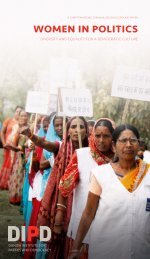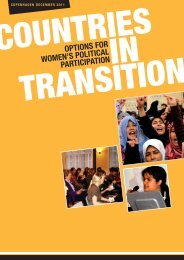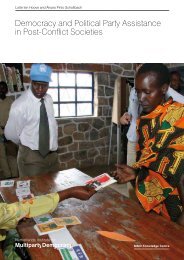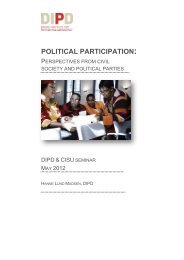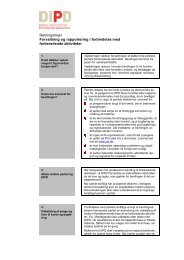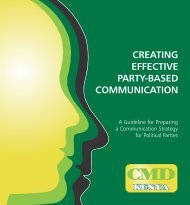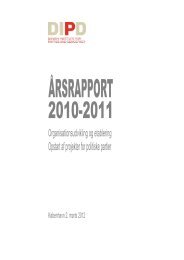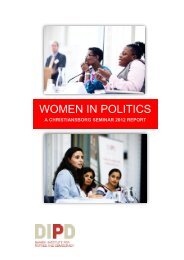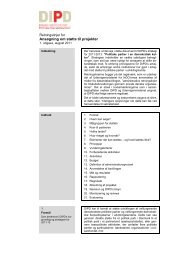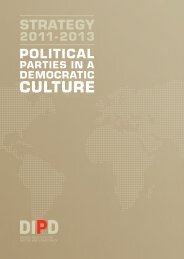Political Parties in Africa: Challenges for Sustained Multiparty
Political Parties in Africa: Challenges for Sustained Multiparty
Political Parties in Africa: Challenges for Sustained Multiparty
Create successful ePaper yourself
Turn your PDF publications into a flip-book with our unique Google optimized e-Paper software.
International Idea<br />
Evidently, post-1990s <strong>Africa</strong>n elections are more peaceful than those of the early<br />
<strong>in</strong>dependence days. There is also more cooperation and to some extent peaceful<br />
party coexistence <strong>in</strong> most <strong>Africa</strong>n states, except a few.<br />
1. In December 1991, only days after the repeal of section 2A of the Kenyan<br />
constitution, which restored the multiparty system, Mwai Kibaki left the<br />
rul<strong>in</strong>g party, the Kenya <strong>Africa</strong>n National Union (KANU), and founded the<br />
Democratic Party (DP), which later became the National Alliance Party of<br />
Kenya (NAK). He f<strong>in</strong>ished third <strong>in</strong> the presidential elections of 1992, and<br />
second (with 31 per cent of votes) <strong>in</strong> those of 1997. In preparation <strong>for</strong> the 2000<br />
elections, the NAK allied itself with the Liberal Democratic Party (LDP) to<br />
<strong>for</strong>m the National Ra<strong>in</strong>bow Coalition (NARC). Opposition groups and civil<br />
society groups united to press <strong>for</strong> a constitutional review. In early 1998, the<br />
ma<strong>in</strong>stream opposition parties (the Forum <strong>for</strong> the Restoration of Democracy-<br />
Kenya, or Ford Kenya, the Democratic Party and the Social Democratic Party)<br />
jo<strong>in</strong>ed the National Convention Executive Council (NCEC) to press <strong>for</strong><br />
constitutional re<strong>for</strong>ms. On 27 December 1997, NARC won a landslide victory<br />
over KANU, with Kibaki w<strong>in</strong>n<strong>in</strong>g 63 per cent of the votes <strong>in</strong> the presidential<br />
elections, aga<strong>in</strong>st only 30 per cent <strong>for</strong> the KANU candidate, Uhuru Kenyatta.<br />
2. In Niger’s 1993 elections two ma<strong>in</strong> contest<strong>in</strong>g coalitions emerged: (a) the<br />
National Movement <strong>for</strong> Society and Development (MNSD), the rul<strong>in</strong>g party<br />
s<strong>in</strong>ce 1960, and its allies the Union Démocratique des Forces Progressistes<br />
(UDFP) and the Union of Democratic Patriots and Progressives (UPDP); and<br />
(b) the Alliance Forces <strong>for</strong> Change (AFC), led by the Democratic and Social<br />
Convention (CDS), with the Nigerien Party <strong>for</strong> Democracy and Socialism<br />
(PNDS) and Nigerien Alliance <strong>for</strong> Democracy and Social Progress (ANDP) as<br />
the other major coalition partners. However, these alliances were reconfigured<br />
<strong>in</strong> the 1995 parliamentary elections, when the PNDS and UPDP jo<strong>in</strong>ed together,<br />
and hence helped to return the MNSD to power. In the 1999 elections, the<br />
majority <strong>in</strong> parliament was held by the MNSD, which <strong>for</strong>med the government<br />
together with the CDS.<br />
3. Malawi exhibited a similar pattern when the opposition alliance of the United<br />
Democratic Front (UDF) and the Alliance <strong>for</strong> Democracy (AFORD) jo<strong>in</strong>ed<br />
<strong>for</strong>ces to w<strong>in</strong> the 1993 referendum with a landslide and create a coalition<br />
government of national unity. It then saw Malawi through multiparty<br />
elections. In the first multiparty election of 1994, the UDF as part of a loose<br />
alliance known as the Common Electoral Group (CEG) won. However, the<br />
1999 elections brought the Malawi Congress Party (the rul<strong>in</strong>g party of the late<br />
dictator Dr Hast<strong>in</strong>gs Kamuzu Banda) to power, with 33 per cent of the votes.<br />
<strong>Africa</strong>n Party and Electoral Systems



